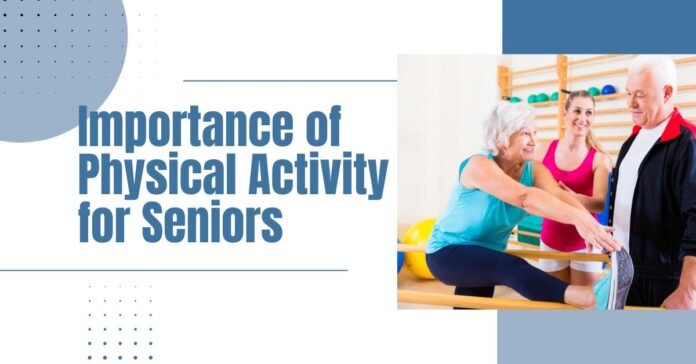Summary: Maintaining regular physical activity is essential for seniors to support overall health, independence, and quality of life. Exercise helps strengthen muscles and bones, improves balance, manages chronic conditions, and boosts cardiovascular, mental, and cognitive health. Staying active also encourages social engagement, emotional resilience, and greater autonomy in daily tasks. Families seeking a senior assisted living facility should consider those that prioritize physical wellness through structured exercise programs, ensuring seniors remain healthy, active, and connected. This holistic approach promotes both well-being and peace of mind for residents and their loved ones.
As people age, maintaining health and independence becomes a top priority. One of the most effective ways to achieve this is through regular physical activity. While exercise is often associated with younger generations, it plays an equally vital role in supporting the well-being of seniors. Staying active not only helps older adults maintain strength and mobility but also enhances overall quality of life.
Consistent physical activity can reduce the risk of chronic illnesses, improve balance, and boost mental health. For seniors, this means fewer hospital visits, greater independence in daily tasks, and a more fulfilling lifestyle. Beyond physical health, exercise also fosters emotional resilience and provides opportunities for social interaction, making it a cornerstone of healthy aging.
Recent data show that just 13.9% of U.S. adults aged 65 and older met both the aerobic and muscle-strengthening components of the federal physical activity guidelines in 2022. This means roughly 7 out of 10 seniors are not getting the full spectrum of exercise recommended for optimal health. The numbers are even lower for the oldest age groups—only about 6.2% of adults aged 85+ meet the guidelines.
Physical inactivity is also strongly tied to higher rates of chronic disease among older Americans. In fact, CDC research shows that adults 50 and older with at least one chronic condition are significantly more likely to be inactive than those without. Inactivity contributes to greater healthcare costs, reduced mobility (walking, standing, climbing stairs), and even declines in mental and cognitive health
Why Physical Activity is Important for Seniors?
As we age, the body naturally undergoes changes muscles weaken, bones lose density, and energy levels decline. Without regular movement, these changes can progress more quickly, affecting independence and overall quality of life. That’s where physical activity plays a crucial role.
For seniors, staying active is not just about fitness—it’s about maintaining health, independence, and confidence. Regular exercise helps manage chronic conditions like diabetes, high blood pressure, and arthritis, reducing the need for multiple medications. It also strengthens balance and coordination, lowering the risk of falls and injuries.
Beyond physical health, activity is a powerful tool for mental and cognitive well-being. It improves memory, sharpens focus, and lowers the risk of dementia, while also reducing feelings of stress, anxiety, and depression. Social activities like group walks, yoga classes, or dance sessions add another layer of benefit by keeping seniors connected and engaged with others.
Benefits of Physical Activity for Seniors
Maintains Bone Density and Muscle Strength
Regular physical activity helps combat age-related bone loss and muscle atrophy (sarcopenia). Weight-bearing exercises like walking, dancing, or resistance training stimulate bone formation and preserve muscle mass, reducing the risk of fractures and maintaining the strength needed for daily activities like climbing stairs or carrying groceries.
Improves Balance and Prevents Falls
Exercise programs that focus on balance, flexibility, and coordination significantly reduce fall risk in older adults. Activities like tai chi, yoga, or simple balance exercises strengthen the core muscles and improve proprioception, helping seniors navigate uneven surfaces and recover from stumbles more effectively.
Enhances Cardiovascular Health and Disease Management
Physical activity strengthens the heart, improves circulation, and helps manage chronic conditions common in older adults such as hypertension, diabetes, and heart disease. Even moderate activities like brisk walking can lower blood pressure, improve cholesterol levels, and enhance overall cardiovascular function.
Supports Mental Health and Cognitive Function
Exercise releases endorphins that combat depression and anxiety while also promoting brain health. Regular physical activity has been shown to improve memory, processing speed, and executive function, potentially reducing the risk of cognitive decline and dementia. The social aspects of group activities also provide valuable mental stimulation and emotional support.
Promotes Independence and Quality of Life
Staying physically active helps seniors maintain the functional capacity needed for independent living. Strong muscles, good balance, and cardiovascular fitness enable older adults to perform activities of daily living, pursue hobbies, travel, and engage with their communities, ultimately contributing to a more fulfilling and autonomous lifestyle.
Embrace Active Living for Healthy Aging
Physical activity is one of the most powerful tools for aging with vitality and purpose. It creates opportunities for seniors to engage with life more fully, from enjoying simple pleasures to building meaningful social connections. By embracing movement as a daily habit, older adults can nurture both body and mind while fostering a greater sense of joy and independence. Every step, stretch, or breath of activity is an investment in a healthier tomorrow.
Families looking for a senior assisted living facility should prioritize those that emphasize physical wellness. Regular activity helps seniors maintain strength, balance, and overall health. Facilities that offer structured exercise programs also support mental clarity and emotional well-being. This approach enables seniors to stay independent and engaged in daily life. At the same time, families gain peace of mind knowing their loved ones are in a safe and supportive environment.



